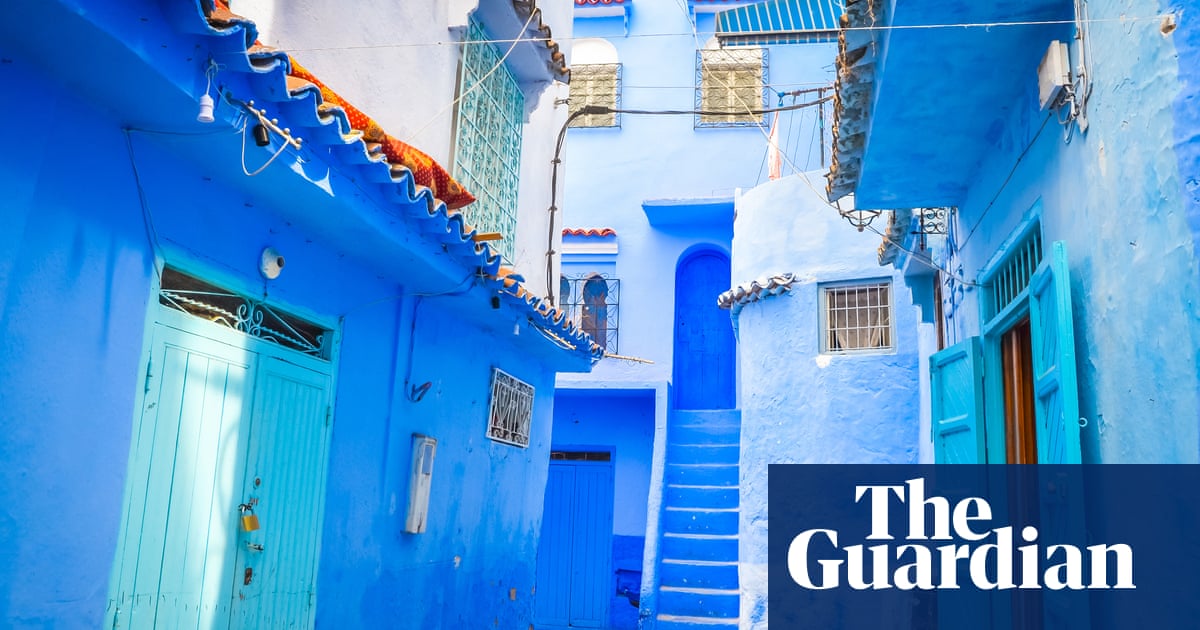Somewhere between the coppersmiths and the woodcarvers, I achieve my goal. Mustapha, my guide, has stepped aside to buy some sweet pastries from a stall. (“You’ve got to try the kaab el ghazal, the ‘gazelle’s horns’. They’re really special.”) But there are some Gnawa musicians, with long black tassels on their hats rotating in time to their drums, and then I cannot resist looking at large copper pots, and the handmade kettles that lead on to brass antiques. I turn. What’s up here? A doorway and the clacking of a hand loom. As-salamu alaykum! Maybe I should head back? A man with a laden donkey bellows, “Balak!” Gangway! I take another turn. Hang on, I don’t recognise any of this.
At that moment, all the colours, tastes, sounds and sights are sprinkled with a magical leavening of adrenaline and the whole lot rises up like some delicious cake in the oven. I glance at the phone in my hand and make sure that location services have failed. It tells me nothing except that I am in Fez, a city of more than a million. The labyrinth has worked. I am lost.
Morocco has many such mazes. There are good ones in Rabat, El Jadida and Essaouira; Marrakech is known to many, and Tangier is wonderful, too. But I’m exploring the north-east of the country, starting with the largest and arguably the best: Fez, considered to be the spiritual and cultural capital.
The labyrinth has obsessed humans for a very long time. King Minos of Crete supposedly incarcerated the minotaur inside the original labyrinth under his palace. As a symbol for life’s uncertain and indirect path, the labyrinth has appeared throughout the ages – check out the Mappa Mundi in Hereford Cathedral. But what, I wonder, as I head deeper into Fez, is it like to live inside a maze? What does that do to the brain? In a world of GPS and satellite-tracking, when every key and sock will soon be instantly located by embedded software, when digital dependency is total and mental-mapping consigned to history, will we dream of getting lost?
Outside one small shop, I watch an old man carve combs from camel bones. There’s a slap on my back. “There you are!” says Mustapha, laughing as always. “We have a saying: those who can speak are never lost.”
We ask the comb-maker, Mohammad Shaïli, about life in the labyrinth. He is 95 years old and has been a resident all his life. “Why should I stop? I’m producing things, I’m no burden on anyone.”
He went once to Marrakech, never any further. He has no boss and is surrounded by friends, family and neighbours. He picks up a small axe and begins expertly splitting tiny sticks of bone. “For putting on mascara.”
How should one enjoy a long life? In the “blue zones”, the world’s reputed longevity hotspots, the keys are said to be diet and active participation in society. I want to know what Mohammad thinks. He grins. “The hand that gives is better than the one that asks.”
Is that a hint? Mustapha presses some money into the elderly man’s hand. “Thanks be to God,” he says happily, “I’ll have fava bean soup for lunch today!”
I suppose we must add “staying alert to opportunities” to that blue zone wishlist.
We head off to find some lunch ourselves. In the meat and fish market, there are no refrigerators. “So people know it is fresh.” The medina’s inhabitants shop daily for their food, a habit that forces constant interaction. Mustapha’s sister married into the Marrakech maze, living in an extended family of 30. She now swears she will never leave. “People feel as if they belong,” Mustapha points out, “and children love it.”
We eat bissara, the Fez favourite winter warmer of fava bean soup, and then mint tea with wormwood leaves, and set off again, stopping at the bucket-maker’s. He has a warning, lest I get too enthusiastic about medina life. “People can be arrogant and there are outlaws.”
I’ve seen a few of those, breezing through the alleyways with a sharp eye for a quick chance. The labyrinth demands concentration from everyone. “In the future,” adds the rather pessimistic craftsman, “the buckets will leak.”
The next day we drive west to see a different kind of maze. The large village of Moulay Idriss Zerhoun is close to the big tourist attraction of Volubilis, a ruined Roman town, but it attracts only a fraction of those visitors to wander its quiet alleyways. “Each neighbourhood has five vital elements,” Mustapha says. “Mosque, hammam, water fountain, school …” The fifth is revealed by a hooded man walking past with a tray covered with a tea towel. He is taking his dough to the communal oven. We follow him and find Ali, firing up the capacious ancient brick oven with gnarly lengths of olive wood.
after newsletter promotion
“Not so many people come these days,” he says. “They have an oven at home.” When we poke our heads in the nearby hammam, however, it is busy. Outside the village, I meet 10-year-old Kemal and his friend on their donkeys. “I’d rather have a donkey than a car,” says the boy. “You can love a car, but it won’t love you back.”
Their ambitions? “I want to be a policeman,” says Kemal.
“Anything except a policeman,” says his friend.
A hundred miles north is our next stop. Chefchaouen has become a tourist honeypot in recent years. Built on a Rif mountainside, this fantastic maze of stairs, alleys and archways was apparently designed by a medieval sorcerer with contributions from mind-bending artist Maurits Escher. Tourism took off when an enterprising hotelier hit on the idea of painting his establishment blue, and others followed suit. This labyrinth is most magical late at night when the visitors have gone to bed.
My final goal, however, is down on the coast at Tétouan, a lovely medieval Arab medina surrounded by a Spanish-style city. Popular with Moroccan holidaymakers, it remains off the beaten track. The medina is a labyrinthine delight: shady white‑washed alleyways, green shutters, arches and tiled fountains that still run from the medieval aqueducts built by refugees in the 15th century.
The market women wear traditional straw hats and sell only things that a local might need: funerary herbs, asparagus stalks and huge rounds of cork from the local forests, handy for plugging up stone jars filled with olives. One septuagenarian trader answers our questions about life in the labyrinth and longevity. “Just dip these dried figs in honey. That’s all you need.” He insists that we eat lots of them before admitting that he doesn’t actually live inside the maze.
As we wander away, I’m wishing that Britain’s mazes were anywhere near as entertaining, and not mostly located in the perfume departments of airport duty-free sections. But Mustapha is chuckling. “That’s the secret,” he says. “Spend time in the labyrinth. Spend time outside. Eat figs. Be your own blue zone.”
The trip was provided by Intrepid Travel, which offers various tours to Morocco. The eight-day North Morocco Adventure starts at £740pp, including accommodation, ground transport, some meals, activities and a local guide
Article by:Source: Kevin Rushby











